- ● homepage
- ● archives
- ● restoration
- ● books
- ● big banners
- ● post board
- ■ neo's search
- ■ about us
- ■ 게재방법 안내
- 개인정보처리방침

- [email protected]
- Tel. 02_335_7922
- Fax. 02_335_7929
- 10:00am~04:30pm
- 월요일~금요일
- 3/3(월) 대체공휴일

Danse Mécanique
정직성_홍승혜 2인展 2014_1106 ▶ 2014_1207 / 월요일 휴관
초대일시 / 2014_1106_목요일_06:00pm
관람시간 / 11:00am~06:00pm / 일요일_01:00pm~06:00pm / 월요일 휴관
누크갤러리 NOOK GALLERY 서울 종로구 북촌로 5나길 86(삼청동 35-192번지) Tel. +82.2.732.7241 www.facebook.com/nookgallery
1997년이었나 보다. 처음 홍승혜의 전시를 본 것은. 기하학적인 형태를 기본 단위로 한 액자들이 압도적인 갤러리 공간을 점유하고 있었다. 전시공간을 하나하나 지날 때마다 반복 되어 배열된 프레임들은 그 당시까지만 해도 낯선 '유기적 기하학'을 느끼기에 부족함이 없었다. 컴퓨터의 기본 단위인 픽셀은 제스처가 절제된 그녀에게 붓으로는 하지 못하던 확장의 세계를 안겨 주었다. 공간을 어떻게 가르고 점유할 것인가에 관심을 가져온 작가의 생각을 그대로 담아낸 전시였다. 그 이후 오랜 기간 작가의 감각, 작품의 변화 과정을 지켜보면서 홍승혜의 아우라는 과연 어디까지인가 몹시 궁금했다.

- 홍승혜_On&On_철에 폴리우레탄_각 49×49×120cm_2014
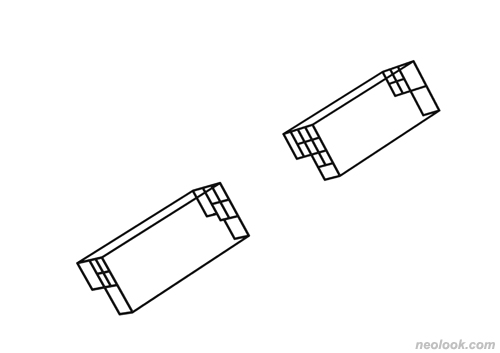
- 홍승혜_On&On_철에 폴리우레탄_각 49×49×120cm
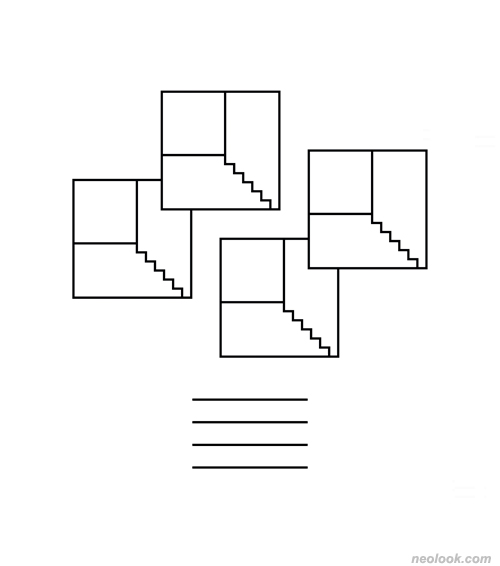
- 홍승혜_On&On_철에 폴리우레탄_92×92×53cm_2014

- 홍승혜_On&On_철에 폴리우레탄_92×92×53cm_2014

- 홍승혜_About Frame_철에 폴리우레탄_39×39×15cm_2014

- 홍승혜_About Frame_철에 폴리우레탄_39×39×15cm_2014
사각형. 프레임. 홍승혜 하면 떠오르는 단어들이다. 전시를 거듭할수록 사각형들은 프레임을 넘어 오브제로, 구조물로, 가구로, 영상으로 우리에게 다가온다. 사각형이 쌓여 스텝, 계단, 엇갈린 구조물을 만들어 낸다. 그것들은 걸음걸이, 움직임, 비틀림을 무의식적으로 나타내고 있다. 정적인 이미지 속에서의 무브먼트! 그 안에 감정의 움직임이 조용하게 리듬을 타고 흐른다.

- 정직성_201448_캔버스에 아크릴채색, 유채_194×259cm_2014
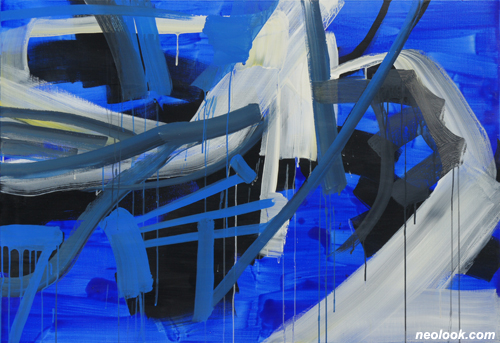
- 정직성_201452_캔버스에 아크릴채색, 유채_89.4×130.3cm_2014
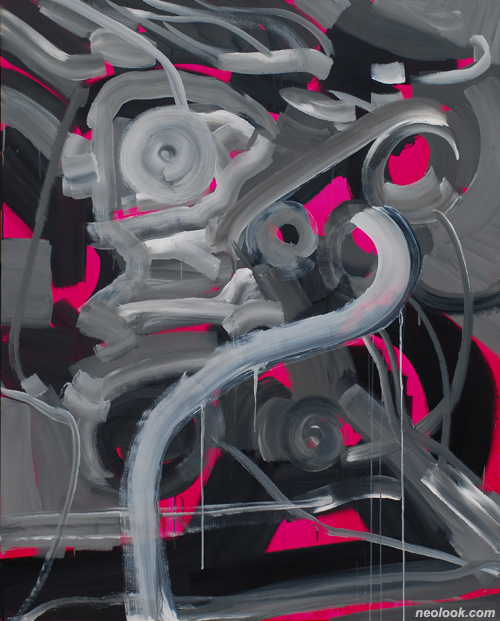
- 정직성_201443_캔버스에 아크릴채색, 유채_162×130.3cm_2014
정직성은 산업 현장에서 볼 수 있는 기계 부품들에서 추출한 요소들을 해체, 재조립한다. 지극히 인공적인 산물인 기계를, 아이러니하게도 유동적인 필획을 강조하여 그린다. 고채도의 바탕색에 저채도의 붓질을 여러 층 쌓아 채도의 역전을 시도해 화면에 불협화음과 같은 긴장감을 가져온다. 분해와 조립이 가능한 소재인 기계는 확고해 보이지 않으며, 임시방편적이고 유동적인 사회의 측면을 드러내고 있는 듯 보인다. ● 기하학적 다이나믹스에서 시작된 홍승혜의 정적인 추상 구조물 속에 흐르는 감정의 움직임, 건축구조와 기계에서 출발한 정직성의 동적인 추상이미지는 20세기 초 페르낭 레제의 '기계미학'에서와 같이 일상에서 볼 수 있는 물건들과 추상적인 형상들, 그리고 그것의 움직임을 연상하게 한다. 절제된 그리드 작업이 발산하는 강렬한 울림과 큰 폭의 무빙 제스처가 연출하는 섬세한 떨림이 어우러진다. 대상 그 자체보다 형식과 확장에 관심을 가지고 작품세계를 구축해 나가는 두 작가는 작품 내부의 서사성을 넘어 형식이 중요하며 그것을 만들어 가는 과정에 집중한다. 대조적인 움직임을 가진 두 작가의 만남을 통해 새로운 조화로움을 경험해 본다. ■ 조정란

- 정직성_201449_캔버스에 아크릴채색, 유채_194×259cm_2014
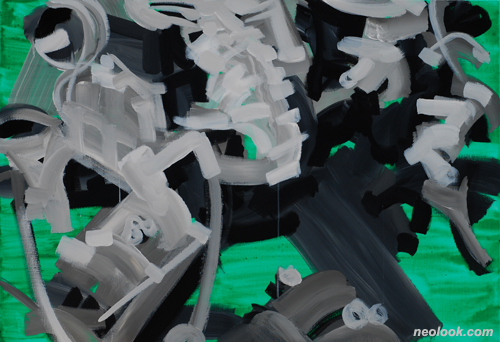
- 정직성_201446_캔버스에 아크릴채색, 유채_89.4×130.3cm_2014
It must have been 1997, when I first saw Hong Seung-Hye's exhibition. Picture frames with geometric forms as basic units were taking over the overwhelming gallery space. The frames arranged in repetitive patterns in each exhibition space were more than enough for me to feel the "organic geometry," which had been an unfamiliar concept at the time. Pixels, which are the basic units of the computer, gave the artist of temperate gesture an extended world she could not approach with a brush. The exhibition was a direct embodiment of the thoughts of the artist, who had been interested in how to divide and occupy space. As I kept an eye on the artist's sensibility and changes in her work for a long time since then, I became very curious about the extent of Hong Seung-Hye's aura. Squares, frames... these are the words that come to mind when I hear the name Hong Seung-Hye. As she continued her exhibitions, the squares transcended the frames and came to us as objects, structures, furniture and video. Squares were stacked to create steps, stairs and oblique structures. Such forms unconsciously represent walking, moving and twisting. Movement within static images! The movement of emotions quietly flows with the rhythm inside. ● Jeong Zik Seong disassembles elements extracted from machine parts that can be seen at industrial sites. She paints extremely artificial machines, ironically with outstanding freely-moving brush strokes. The artist stacks many layers of low-chroma machines against a high-chroma background in an attempt to overturn the chromatic balance, thereby bringing a dissonant tension to the picture-plane. The machine does not appear solid, and seems to reveal the temporary and fluid aspects of society. By painting the spiritual aspect, which is stressed in abstract painting, by means of realistic subject matter, the artist puts a twist on the interpretation. Jeong Zik Seong, however, does not emphasize spirituality or self-cultivation through ascetic practice, as did existing abstract painting traditions. ● The movement of emotions flowing in Hong Seung-Hye's static abstract structures, which began from geometrical dynamics, and Jeong Zik Seong's dynamic abstract images, which started from architectural structures and machinery, remind us of objects from the everyday, abstract forms and their movement, as in Fernand Lége's "mechanical aesthetics" in the early 20th century. Powerful resonance emitted from disciplined grids and delicate trembling produced from moving gestures with extensive width join in harmony. The two artists, who build their worlds of art based on an interest in the form and extension rather than the subject itself, understand the importance of form beyond the narratives within the works, and focus on the process of making them. It is time to experience a new state of harmony through an encounter with two artists with contrasting movements. ■ Cho Jung-ran
Vol.20141106g | Danse Mécanique-정직성_홍승혜 2인展

